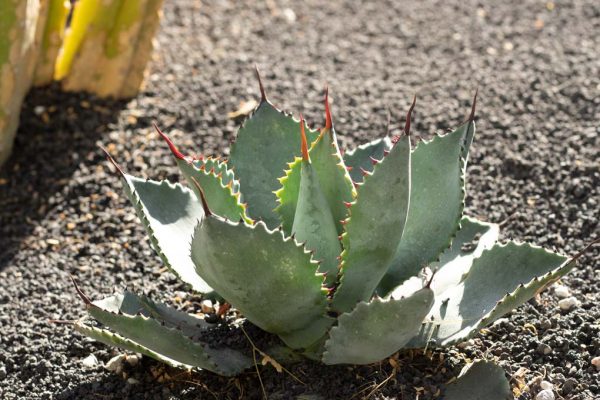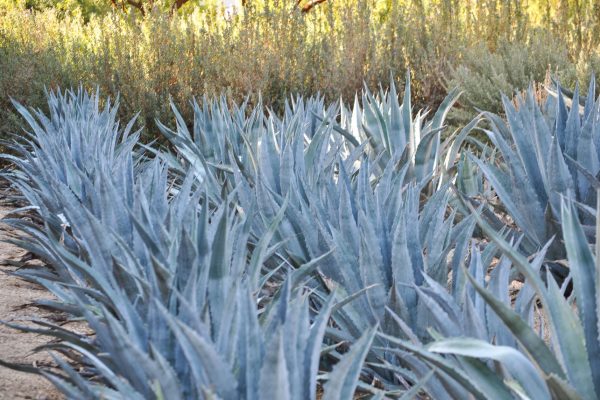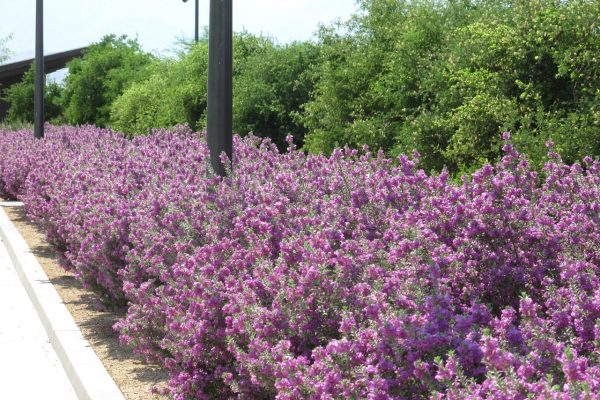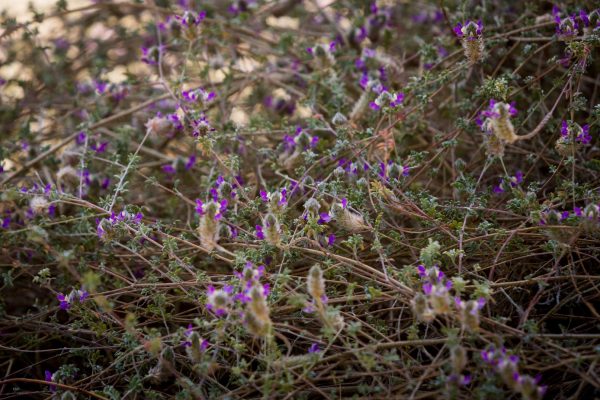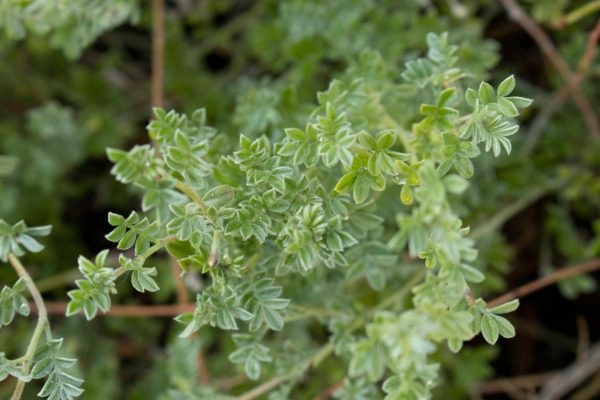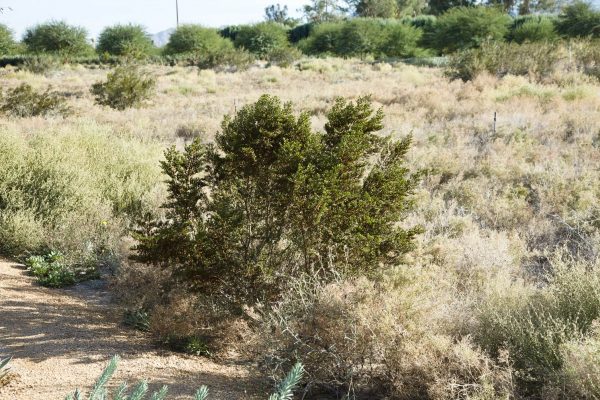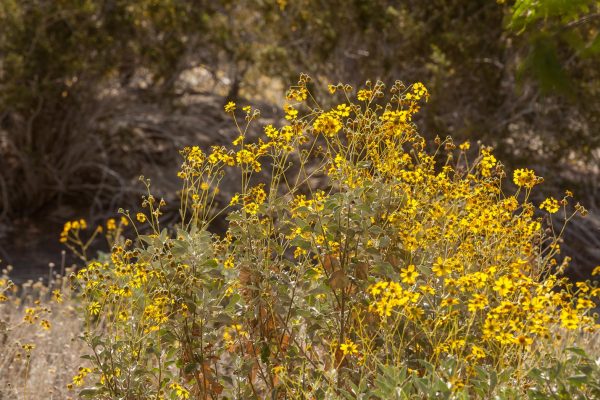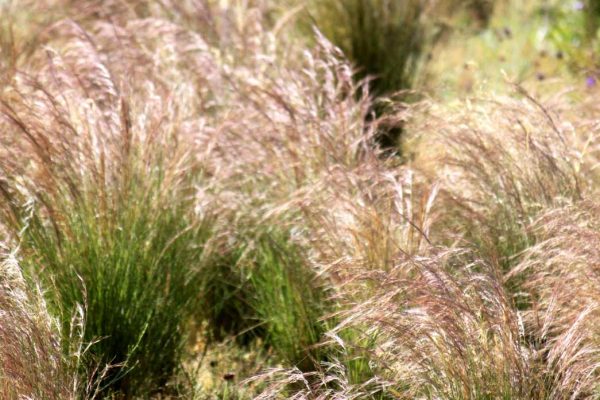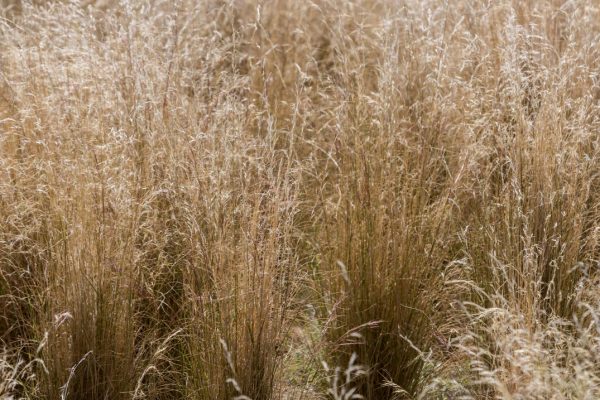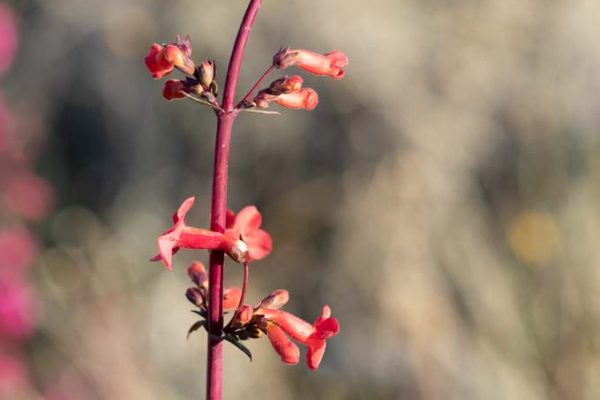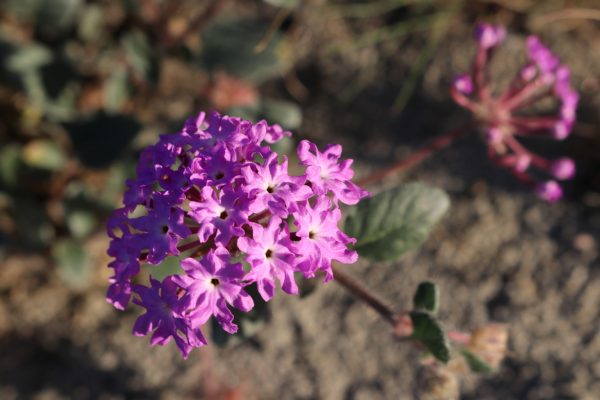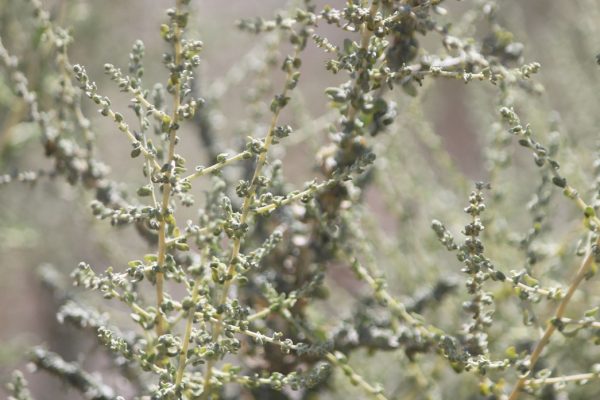Added to the gardens in 2021, Pygmaea Agave is a new dwarf variety. It is dark green with flat leaves rarely exceeding 12 inches (30 cm) in length. It can be found in the far north specimen beds near the solar field.
Pygmaea prefers a limestone habitat. Its origins are in Mexico, Chiapas, and north of the Mexico-Guatemala border.
A slow grower, it does well in heat but is frost tender.
You may find it under the botanical name of Agave Pygmaea Gentry or Agave seemanniana subsp. Pygmaea, which is how it is listed on this site.

The Century Plant, or americana, is the largest agave in the gardens. It’s variable in color, ranging from green to blue-gray, and some varieties displaying variegated leaves. This species is the iconic representation of the genus selected by botanist Carl Linnaeus. It can grow up to 10 feet. The long leaves can recurve dramatically, and leaf margins display brown teeth.
The name Century Plant refers to the monocarpic (one bloom) nature of the genus, where blooms occur only after several years, sometimes up to 30 years, though it may seem like a century for some to bloom.
The inflorescence (flowering stalk) can reach up to 26 feet with 15 to 35 branches on the upper third of the stem. The blooms are yellow and appear in summer. The bloom cycle is dependent on climate and in warmer regions may happen at around 10 years. In cooler climates, it may take up to 35 years to bloom. The plant will die after that bloom but has likely produced many clones around its base in the meantime.
Its distribution is uncertain but widespread.

Leucophyllum is the genus for a group of hardy desert shrubs. Most people know it from the common name Texas Ranger or Texas Sage, though it is not a Salvia. Years of commercial cultivation has created a variety of sizes and colors that guarantee a visual variation for almost every desert garden. It blooms in ranges of deep purple to violet and periwinkle, and its fuzzy leaves range from green to silver-gray. Even its size can vary from large shrubs, reaching 6 feet, to smaller compact shrubs.
Sunnylands initially installed six specimens of Leucophyllum spp., but over the years, there have been a few species that triumphed in the gardens. They were the most pest resistant and stood out in color and form. We have reduced the original six to three highlighted species. They are distributed throughout the gardens and can be identified by leaf and/or bloom. The three are, by common name: Green Cloud, Heavenly Cloud, and Sierra Bouquet. They are grouped together here under their genus Leucophyllum, so that their visual features are easy to compare when standing in the gardens.
GREEN CLOUD (Leucophyllum frutescens ‘Green Cloud’)
Green foliage with purple flowers
HEAVENLY CLOUD (Leucophyllum x. ‘Heavenly Cloud’)
Green foliage with bright purple flowers
SIERRA BOUQUET (Leucophyllum pruinosum ‘Sierra Bouquet’)
Gray foliage with periwinkle flowers

This member of the pea family is a shrub that spreads, forming low-mounding hedges with small, fuzzy, silver-green leaves. It’s a popular choice for ground cover in difficult locations like slopes or medians as it can handle full sun and reflected heat. Though its stems can get woody, it often grows back over those sections creating some cover habitat for wildlife. It requires well-drained soil.
Its blooms are small stalks with fuzzy, purple flowers.
Trailing Indigo Bush is native to Texas.
Tested for a couple years in the labyrinth, it was determined not to be a good fit and was replaced with the current Wedelia (Sphagneticola trilobata). It is still used around the wildflower field.
A LOOK ALIKE: At Sunnylands we have two similar species in the the Dalea genus. This offers a choice based on preference for bloom color of purple or yellow. This other species is known as Sierra Gold (Dalea capetata). It can be distinguished by its leaves, which are more of a bright green, and its yellow flower blooms.
Sierra Gold is a trailing groundcover planted along the entry drive and around the performance circle. It was not part of the original planting list, and was added a few years after opening in 2012.
LOOK ALIKE: It grows similarly to Trailing Indigo Bush, which was part of the original plant list installed prior to 2012. Both species are great choices for hot or reflected heat locations and slopes. The choice comes down to whether there is a preference for the true green and yellow flowers of Sierra Gold or the gray-green leaves and purple flowers of the Trailing Indigo Bush.
Native to Coahuila, Mexico.
The one species of shrub that was here before Sunnylands was developed and left undisturbed in the wildflower field is Creosote. These are the largest shrubs that you can see in the field with small resinous wax-coated leaves. They have a wet scent reminiscent of rain on the desert.
Native to Mexico, as the climate became warmer and drier, the Creosote moved north, arriving in our area less than 20,000 years ago, which is relatively recent. Since arriving, it has filled a niche with more than 20 species of bees as its major pollinators. It is also food for the Chuckwalla, Desert Iguana, and Black-tailed Jackrabbit, though the jackrabbit will only select Creosote if other more palatable options are not available. The leaves are quite bitter.
There are significant ethnobotanical connections to this plant, and some medicinal uses are being researched today.

Brittlebush, a member of the sunflower family, is a medium desert shrub with fuzzy, silver-green leaves that is common along desert roads and medians. It is an extremely durable desert native. The fuzzy coating on the leaves is a desert adaptation that provides protection from the sun, allows for temperature regulation, and helps capture moisture—a strategy that contributes to its durability. At Sunnylands, it can be found in the wildflower field. The name Brittlebush comes from its stems, which are woody and easily broken. It is easily cultivated, grows quickly, and will expand to about 5 feet in height and can spread its branches to a 5-foot span.
It blooms in late winter and early spring with yellow daisy-like flowers, growing from small stems in clusters that look like they are floating above the leaves.
The range for Brittlebush extends through the Sonora Desert, warmer regions of the Mojave, and in some coastal areas of southern California. In Mexico, it is in Baja California, Baja California Sur, Sonora, Sinaloa, and Hidalgo.
Purple Threeawn is a native perennial bunch grass of North America, but is short lived. It lasts longer than an annual, but not as long as other perennials, depending on care. It spreads by seed and can overwhelm a space if not controlled. It is very drought tolerant.
It has a very soft, feathery look. The stalk is tinted purple and moves in waves in the breeze. It is a striking bunch grass and softens the look of the desert wildflower fields, providing background for wildflowers.
It is native across the southern United States.
Indian ricegrass is a bunch grass, which means it grows as a cluster and is not a spreading grass like turf. It has narrow, rolled leaf blades and is topped with clusters of flowers and seedpods. This cool-season perennial is one of three bunch grasses in the wildflower field that serve as important larval hosts for pollinators, and in sandy soil or scrub, provides stabilization for the sand. It can survive in a variety of habitats and clay soils, although it has a preference for sandy soils. The empty seedpods catch the light and create a glowing effect in bright sun.
The plant is a North American native, with a range extending from southern California up through British Columbia and Alberta and east of the Cascades to Texas and northeastern Mexico.

Found mostly in the Mojave Desert, Desert Penstemon is a robust, blooming plant that never fails to impress. It flowers mainly in reddish pink tones, but cultivated varieties of many colors are in nurseries today. Hummingbirds are attracted to its blooms, and songbirds follow to collect seed. The dried stalks and seed heads rise above the leaf base that can turn to lighter yellows later in season. The stalks can be cut off or left through fall and winter to add interest.
Starting in 2018, Penstemon plants were added to the wildflower field. Originals were transplanted from pots to get them started. They were left to disperse seed, from which additional plants have grown.
The Wildflower Field
The wildflower field at Sunnylands is overseeded annually with native wildflowers and bunch grasses. This provides visitors with a view of the larger cyclical bloom cycles that we have in the desert. Starting in February, a variety of native species and bunch grasses begin emerging. Each year the vegetation varies slightly, depending on which seed dominates the space. The field can range in color from purples to oranges, whites, and pinks, with a variety of combinations. We cannot guarantee that all wildflowers will be present each year.

One of the most familiar desert wildflowers is the Sand Verbena. It is very successful in disturbed areas as well as in dunes and other desert spaces. If heavy rains occur in the months leading up to the bloom season, it is likely that Sand Verbena will dominate the fields and sandy lots throughout the desert. Each plant can expand up to 3 feet and in good seasons create a purple carpet across sandy fields. It is quite often intermixed with Dune Primrose, which is also in the wildflower field.
The name Abronia means “graceful” in Greek and describes the delicate dome-shaped flower clusters. The Abronia villosa will start blooming in spring and at high elevations may continue into June. Sometimes it can begin blooming as early as November.
Western North America is home to all 25 known species of Sand Verbena that range from coastal to desert sand dune ecosystems, including washes and coastal dunes. They can grow in other habitats, but these are primary.
The Wildflower Field
The wildflower field at Sunnylands is overseeded annually with native wildflowers and bunch grasses. This provides visitors with a view of the larger cyclical bloom cycles that we have in the desert. Starting in February, a variety of native species and bunch grasses begin emerging. Each year the vegetation varies slightly, depending on which seed dominates the space. The field can range in color from purples to oranges, whites, and pinks, with a variety of combinations. We cannot guarantee that all wildflowers will be present each year.
This desert shrub is widespread in desert habitats and does best in alkaline plains. Salt Bush can tolerate soil conditions that other desert natives cannot. It does well with Creosote, but is sometimes found in pure stands with few to no other species. It has a unique adaptation to eliminate the high salt content in desert soil. The hairs on the leaves excrete the salts onto the plant surface. This not only removes the salt from within the plant, but the excreted salt then creates a sunblock on the plant surface. It gives Salt Bush a gray appearance.
It blooms with clusters of cream-colored flowers. This is one plant that requires both a male and female plant for pollination.
It is native to the southwestern United States and northern Mexico.
